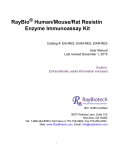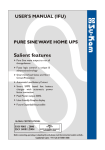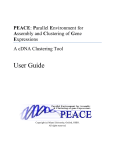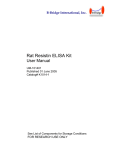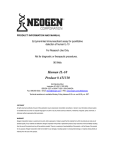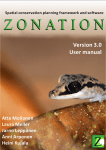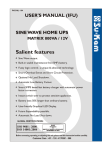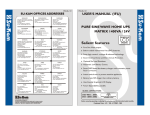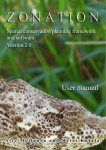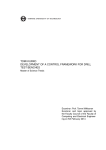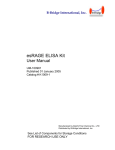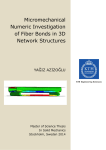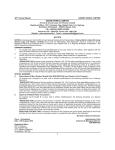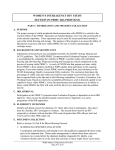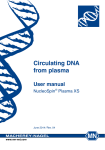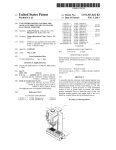Download IFU - DRG International
Transcript
DRG® Resistin (human) ELISA REVISED 7 APRIL 2014 RM (VERS. 7.1) (EIA-4572) RUO IN THE USA AND NON-EU COUNTRIES This kit is intended for Research Use Only. Not intended for diagnostic purposes. Please use only the valid version of the package insert provided with the kit. 1 INTENDED USE The Resistin (human) ELISA is a sandwich enzyme immunoassay for measurement of human resistin. Features The total assay time is less than 4 hours. The kit measures total resistin in serum and plasma (EDTA, citrate, heparin), Assay format is 96 wells. Quality Controls are human serum based. Standard is recombinant protein based. Components of the kit are provided ready to use, concentrated or lyophilized. 2 STORAGE, EXPIRATION Store the complete kit at 2 °C - 8 °C. Under these conditions, the kit is stable until the expiration date (see label on the box). 3 INTRODUCTION Resistin, a product of the RSTN gene, is a peptide hormone belonging to the class of cysteine-rich secreted proteins which is termed the RELM family, and is also described as ADSF (Adipose Tissue-Specific Secretory Factor) or FIZZ3 (Found in Inflammatory Zone). Human resistin contains 108 amino acids as a prepeptide, and its hydrophobic signal peptide is cleaved before its secretion. Resistin circulates in human blood as a dimeric protein consisting of two 92 amino acid polypeptides, which are disulfide-linked via Cys26. Much of the early investigations about the resistin molecule are based on the mouse model. Resistin, produced and secreted primarily by adipocytes in mice, acts on skeletal muscle myocytes, hepatocytes and adipocytes themselves so that it reduces their sensitivity to insulin. Steppan et al. have suggested that resistin suppresses the ability of insulin to stimulate glucose uptake. Other studies have shown that mouse resistin increases during the differentiation of adipocytes, but it also seems to inhibit adipogenesis. Compared to the mouse model, human adipogenic differentiation is likely to be associated with a down regulation of resistin gene expression. On the other hand, resistin was found to be expressed at high levels in human monocytes, macrophages and bone marrow. DRG International, Inc. USA Fax: (973) 564-7556 e-mail: [email protected] 1 DRG® Resistin (human) ELISA REVISED 7 APRIL 2014 RM (VERS. 7.1) (EIA-4572) RUO IN THE USA AND NON-EU COUNTRIES 4 TEST PRINCIPLE In the DRG Resistin (human) ELISA, standards, quality controls and samples are incubated in microplate wells pre-coated with polyclonal anti-human resistin antibody. After 60 minutes incubation and washing, biotin-labelled second polyclonal anti-human resistin antibody is added and incubated with captured resistin for 60 minutes. After another washing, streptavidin-HRP conjugate is added. After 60 minutes incubation and the last washing step, the remaining conjugate is allowed to react with the substrate solution (TMB). The reaction is stopped by addition of acidic solution and absorbance of the resulting yellow product is measured. The absorbance is proportional to the concentration of resistin. A standard curve is constructed by plotting absorbance values against concentrations of standards, and concentrations of unknown samples are determined using this standard curve. 5 PRECAUTIONS For professional use only. Wear gloves and laboratory coats when handling kit materials. Do not drink, eat or smoke in the areas where kit materials are being handled. This kit contains components of human origin. These materials were found nonreactive for HBsAg, HCV antibody and for HIV 1/2 antigen and antibody. However, these materials should be handled as potentially infectious, as no test can guarantee the complete absence of infectious agents. This kit contains components of animal origin. These materials should be handled as potentially infectious. Avoid contact with the acidic Stop Solution and Substrate Solution, which contains hydrogen peroxide and tetramethylbenzidine (TMB). Wear gloves and eye and clothing protection when handling these reagents. Stop and/or Substrate Solutions may cause skin/eyes irritation. In case of contact with the Stop Solution and the Substrate Solution wash skin/eyes thoroughly with water and seek medical attention, when necessary. The materials must not be pipetted by mouth. 6 TECHNICAL HINTS Reagents with different lot numbers should not be mixed. Use thoroughly clean glassware. Use deionized (distilled) water, stored in clean containers. Avoid any contamination among samples and reagents. For this purpose, disposable tips should be used for each sample and reagent. Substrate Solution should remain colourless until added to the plate. Keep Substrate Solution protected from light. Stop Solution should remain colourless until added to the plate. The colour developed in the wells will turn from blue to yellow immediately after the addition of the Stop Solution. Wells that are green in colour indicate that the Stop Solution has not mixed thoroughly with the Substrate Solution. Dispose of consumable materials and unused contents in accordance with applicable national regulatory requirements. DRG International, Inc. USA Fax: (973) 564-7556 e-mail: [email protected] 2 DRG® Resistin (human) ELISA RUO IN THE USA AND NON-EU COUNTRIES REVISED 7 APRIL 2014 RM (VERS. 7.1) 7 (EIA-4572) REAGENT SUPPLIED Kit Components State Quantity Antibody Coated Microtiter Strips ready to use 96 wells Biotin Labelled Antibody ready to use 13 mL Streptavidin-HRP Conjugate ready to use 13 mL Master Standard lyophilized 1 vial Quality Control HIGH lyophilized 1 vial Quality Control LOW lyophilized 1 vial Dilution Buffer ready to use 20 mL Wash Solution Conc. (10x) concentrated 100 mL Substrate Solution ready to use 13 mL Stop Solution ready to use 13 mL - 1 pc Instructions for Use + Certificate of Analysis 8 MATERIAL REQUIRED BUT NOT SUPPLIED Deionized (distilled) water Test tubes for diluting samples Glassware (graduated cylinder and bottle) for Wash Solution (Dilution Buffer) Precision pipettes to deliver 10-1000 µL with disposable tips Multichannel pipette to deliver 100 µL with disposable tips Absorbent material (e.g. paper towels) for blotting the microtitrate plate after washing Vortex mixer Orbital microplate shaker capable of approximately 300 rpm Microplate washer (optional). [Manual washing is possible but not preferable.] Microplate reader with 450 ± 10 nm filter preferably with reference wavelength 630 nm (alternatively another one from the interval 550 – 650 nm) Software package facilitating data generation and analysis (optional) 9 PREPARATION OF REAGENTS All reagents need to be brought to room temperature prior to use. Always prepare only the appropriate quantity of reagents for your test. Do not use components after the expiration date marked on their label. DRG International, Inc. USA Fax: (973) 564-7556 e-mail: [email protected] 3 DRG® Resistin (human) ELISA REVISED 7 APRIL 2014 RM (VERS. 7.1) (EIA-4572) RUO IN THE USA AND NON-EU COUNTRIES 9.1 Assay reagents supplied ready to use 1. Antibody Coated Microtiter Strips Stability and storage: Return the unused strips to the provided aluminium zip-sealed bag with desiccant and seal carefully. Remaining Microtiter Strips are stable 3 months stored at 2 °C - 8 °C and protected from the moisture. 2. Biotin Labelled Antibody 3. Streptavidin-HRP Conjugate 4. Dilution Buffer 5. Substrate Solution 6. Stop Solution Stability and storage: Opened reagents are stable 3 months when stored at 2 °C - 8 °C. 9.2 Assay reagents supplied concentrated or lyophilized 1. Human Resistin Master Standard Refer to the Certificate of Analysis for current volume of Dilution Buffer needed for reconstitution of standard! Reconstitute the lyophilized Master Standard with Dilution Buffer just prior to the assay. Let it dissolve at least 15 minutes with occasional gentle shaking (not to foam). The resulting concentration of the resistin in the stock solution is 50 ng/mL. Prepare set of standards using Dilution Buffer as follows: DRG International, Inc. USA Fax: (973) 564-7556 e-mail: [email protected] 4 DRG® Resistin (human) ELISA RUO IN THE USA AND NON-EU COUNTRIES REVISED 7 APRIL 2014 RM (VERS. 7.1) Volume of Standard stock 500 µL of stock 500 µL of std. 20 ng/mL 500 µL of std. 10 ng/mL 500 µL of std. 5 ng/mL 500 µL of std. 2 ng/mL Dilution Buffer ----750 µL 500 µL 500 µL 750 µL 500 µL (EIA-4572) Concentration 50 ng/mL 20 ng/mL 10 ng/mL 5 ng/mL 2 ng/mL 1 ng/mL Dilute each concentration of standard 3x with Dilution Buffer prior to the assay, e.g. 50 µL of standard + 100 µL of Dilution Buffer for singlets, or preferably 100 µL of standard + 200 µL of Dilution Buffer for duplicates. Mix well (not to foam). Stability and storage: Set of Standards (50 - 1 ng/mL) should be aliquoted and frozen at –20 °C for 3 months. Avoid repeated freeze/thaw cycles. Do not store the diluted Standard solutions. 2. Quality Controls High, Low Refer to the Certificate of Analysis for current Quality Control concentration! Reconstitute each Quality Control (High and Low) with 350 µL of Dilution Buffer just prior to the assay. Let it dissolve at least 30 minutes with occasional gentle shaking (not to foam). Dilute Quality Controls prior to the assay 3x with Dilution Buffer, e.g. 50 µL of Quality Control + 100 µL of Dilution Buffer for singlets, or preferably 100 µL of Quality Control + 200 µL of Dilution Buffer for duplicates Stability and storage: The reconstituted Quality Controls must be used immediately or aliquoted and frozen at -20 °C for 3 months. Avoid repeated freeze/thaw cycles. Do not store the diluted Quality Controls. Note: Concentration of analyte in Quality Controls need not be anyhow associated with normal and/or pathological concentrations in serum or another body fluid. Quality Controls serve just for control that the kit works in accordance the with user’s manual and Certificate of Analysis and that ELISA test was carried out properly. 3. Wash Solution Conc. (10x) Dilute Wash Solution Concentrate (10x) ten-fold in distilled water to prepare a 1x working solution. DRG International, Inc. USA Fax: (973) 564-7556 e-mail: [email protected] 5 DRG® Resistin (human) ELISA REVISED 7 APRIL 2014 RM (VERS. 7.1) (EIA-4572) RUO IN THE USA AND NON-EU COUNTRIES Example: 100 mL of Wash Solution Concentrate. (10x) + 900 mL of distilled water for use of all 96-wells. Stability and storage: The diluted Wash Solution is stable 1 month when stored at 2 °C - 8 °C. Opened Wash Solution Concentrate (10x) is stable 3 months when stored at 2 °C - 8 °C. 10 PREPARATION OF SAMPLES The kit measures human resistin (homodimeric) in serum and plasma (EDTA, citrate, heparin). Samples should be assayed immediately after collection or should be stored at -20 °C. Mix thoroughly thawed samples just prior to the assay and avoid repeated freeze/thaw cycles, which may cause erroneous results. Avoid using hemolyzed or lipemic samples. Dilute samples 3x with Dilution Buffer just prior to the assay (e.g. 50 µL of sample + 100 µL of Dilution Buffer for singlets, or preferably 100 µL of sample + 200 µL of Dilution Buffer for duplicates). Mix well (not to foam). Vortex is recommended. Stability and storage: Samples should be stored at -20 °C, or preferably at -70 °C for long-term storage. Do not store the diluted samples. See Chapter 13 for stability of serum and plasma samples when stored at 2 °C - 8 °C, effect of freezing/thawing and effect of sample matrix (serum/plasma) on the concentration of human resistin. Note: It is recommended to use a precision pipette and a careful technique to perform the dilution in order to get precise results. Ask for protocol at [email protected] if assaying tissue culture medium, synovial fluid and cerebrospinal fluid (CSF). 11 ASSAY PROCEDURE 1. Pipet 100 µL of diluted Standards, Quality Controls, Dilution Buffer (=Blank) and samples, preferably in duplicates, into the appropriate wells. See Figure 1 for example of work sheet. 2. Incubate the plate at room temperature (ca. 25 °C) for 1 hour, shaking at ca. 300 rpm on an orbital microplate shaker. 3. Wash the wells 3-times with Wash Solution (0.35 mL per well). After final wash, invert and tap the plate strongly against paper towel. 4. Add 100 µL of Biotin Labelled Antibody solution into each well. 5. Incubate the plate at room temperature (ca. 25 °C) for 1 hour, shaking at ca. 300 rpm on an orbital microplate shaker. 6. Wash the wells 3-times with Wash Solution (0.35 mL per well). After final wash, invert and tap the plate strongly against paper towel. 7. Add 100 µL of Streptavidin-HRP Conjugate into each well. DRG International, Inc. USA Fax: (973) 564-7556 e-mail: [email protected] 6 DRG® Resistin (human) ELISA REVISED 7 APRIL 2014 RM (VERS. 7.1) (EIA-4572) RUO IN THE USA AND NON-EU COUNTRIES 8. Incubate the plate at room temperature (ca. 25 °C) for 1 hour, shaking at ca. 300 rpm on an orbital microplate shaker. 9. Wash the wells 3-times with Wash Solution (0.35 mL per well). After final wash, invert and tap the plate strongly against paper towel. 10. Add 100 µL of Substrate Solution into each well. Avoid exposing the microtiter plate to direct sunlight. Covering the plate with e.g. aluminium foil is recommended. 11. Incubate the plate for 10 minutes at room temperature. The incubation time may be extended [up to 20 minutes] if the reaction temperature is below than 20 °C. Do not shake the plate during the incubation. 12. Stop the colour development by adding 100 µL of Stop Solution. 13. Determine the absorbance of each well using a microplate reader set to 450 nm, preferably with the reference wavelength set to 630 nm (acceptable range: 550 – 650 nm). Subtract readings at 630 nm (550 - 650 nm) from the readings at 450 nm. The absorbance should be read within 5 minutes following step 12. Note: If some samples and standard/s have absorbances above the upper limit of your microplate reader, perform a second reading at 405 nm. A new standard curve, constructed using the values measured at 405 nm, is used to determine resistin concentration of off-scale standards and samples. The readings at 405 nm should not replace the readings for samples that were “in range” at 450 nm. Note 2: Manual washing: Aspirate wells and pipet 0.35 mL Wash Solution into each well. Aspirate wells and repeat twice. After final wash, invert and tap the plate strongly against paper towel. Make certain that Wash Solution has been removed entirely. DRG International, Inc. USA Fax: (973) 564-7556 e-mail: [email protected] 7 DRG® Resistin (human) ELISA RUO IN THE USA AND NON-EU COUNTRIES REVISED 7 APRIL 2014 RM (VERS. 7.1) A B C D E F G H strip 1+ 2 Standard 50 Standard 20 Standard 10 Standard 5 Standard 2 Standard 1 Blank QC High strip 3 + 4 QC Low Sample 1 Sample 2 Sample 3 Sample 4 Sample 5 Sample 6 Sample 7 strip 5+ 6 Sample 8 Sample 9 Sample 10 Sample 11 Sample 12 Sample 13 Sample 14 Sample 15 (EIA-4572) strip 7+ 8 Sample 16 Sample 17 Sample 18 Sample 19 Sample 20 Sample 21 Sample 22 Sample 23 strip 9+10 Sample 24 Sample 25 Sample 26 Sample 27 Sample 28 Sample 29 Sample 30 Sample 31 strip 11+ 12 Sample 32 Sample 33 Sample 34 Sample 35 Sample 36 Sample 37 Sample 38 Sample 39 Figure 1: Example of a work sheet. 12 CALCULATIONS Most microtiter plate readers perform automatic calculations of analyte concentration. The standard curve is constructed by plotting the mean absorbance (Y) of Standards against the known concentration (X) of Standards in logarithmic scale, using the four-parameter algorithm. Results are reported as concentration of resistin in ng/mL in samples. Alternatively, the logit log function can be used to linearize the standard curve (i.e. logit of the mean absorbance (Y) is plotted against log of the known concentration (X) of Standards). Samples, Quality Controls and Standards are all diluted 3x prior to analysis, so there is no need to take this dilution factor into account. DRG International, Inc. USA Fax: (973) 564-7556 e-mail: [email protected] 8 DRG® Resistin (human) ELISA REVISED 7 APRIL 2014 RM (VERS. 7.1) (EIA-4572) RUO IN THE USA AND NON-EU COUNTRIES Human Resistin ELISA Standard Curve Absorbance (A450 nm - A630 nm) 3,0 2,5 2,0 1,5 1,0 0,5 0,0 1 10 Concentration of Human Resistin (ng/ml) Figure 2: Typical Standard Curve for Human Resistin ELISA. 12.1 Effect of sample matrix Heparin, citrate and EDTA plasmas were compared to respective serum samples from the same 10 individuals. Results are shown below: DRG International, Inc. USA Fax: (973) 564-7556 e-mail: [email protected] 9 DRG® Resistin (human) ELISA RUO IN THE USA AND NON-EU COUNTRIES REVISED 7 APRIL 2014 RM (VERS. 7.1) Volunteer No. 1 2 3 4 5 6 7 8 9 10 Mean (ng/mL) Mean Plasma/Serum (%) Coefficient of determination R2 (EIA-4572) Plasma (ng/mL) Heparin Citrate EDTA 5.66 4.54 6.60 10.07 8.97 11.69 7.20 6.31 9.53 4.39 3.43 3.96 2.95 2.25 2.78 7.86 8.12 12.29 11.47 9.48 14.62 4.74 4.14 7.09 5.11 4.40 6.41 5.68 4.85 5.80 6.51 5.65 8.08 106.9% 92.7% 132.6% 0.97 0.94 0.89 Serum (ng/mL) 5.13 9.99 7.22 3.89 2.31 7.02 10.47 4.85 5.22 4.82 6.09 Effect of Sample Matrix Serum EDTA Plasma 16 Citrate Plasma Concentration of Human Resistin (ng/ml) 14 Heparin Plasma 12 10 8 6 4 2 0 1 2 3 4 5 6 7 8 9 10 Volunteers DRG International, Inc. USA Fax: (973) 564-7556 e-mail: [email protected] 10 DRG® Resistin (human) ELISA (EIA-4572) RUO IN THE USA AND NON-EU COUNTRIES REVISED 7 APRIL 2014 RM (VERS. 7.1) Figure 3: Resistin levels measured using Human Resistin ELISA from10 individuals using serum, heparin, citrate and EDTA plasma, respectively. 12.2 Stability of samples stored at 2 °C - 8 °C Samples should be stored at -80 °C. However, no decline in concentration of resistin was observed in serum and plasma samples after 7 days when stored at 2 °C - 8 °C. To avoid microbial contamination, samples were treated with εaminocaproic acid and sodium azide, resulting in the final concentration of 0.03% and 0.1%, respectively. Sample 1 2 3 Plasma (ng/ml) Incubation Temp, Period Serum (ng/ml) EDTA Citrate Heparin -80 °C 4.11 4.60 4.31 5.04 2 °C - 8 °C, 1 day 4.23 4.76 3.77 4.59 2 °C - 8 °C, 7 days 4.27 4.84 3.69 4.95 -80 °C 6.21 6.63 5.18 7.95 2 °C - 8 °C, 1 day 6.46 6.79 5.17 8.91 2 °C - 8 °C, 7 days 7.12 6.24 5.06 8.47 -80 °C 9.62 9.85 9.72 12.94 2 °C - 8 °C, 1 day 9.17 9.74 8.33 12.23 2 °C - 8 °C, 7 days 8.71 9.85 8.91 12.18 12.3 Effect of Freezing/Thawing No decline was observed in concentration of human resistin in serum and plasma samples after repeated (3x) freeze/thaw cycles. However it is recommended to avoid unnecessary repeated freezing/thawing of the samples. DRG International, Inc. USA Fax: (973) 564-7556 e-mail: [email protected] 11 DRG® Resistin (human) ELISA REVISED 7 APRIL 2014 RM (VERS. 7.1) Volunteer No. 1 2 3 Number of f/t cycles 1x 3x 5x 1x 3x 5x 1x 3x 5x Serum (ng/mL) 2.31 2.13 1.94 3.58 3.65 3.64 4.34 4.53 3.97 (EIA-4572) RUO IN THE USA AND NON-EU COUNTRIES Plasma (ng/mL) Heparin Citrate EDTA 2.38 2.29 2.63 2.24 2.35 2.47 2.15 2.38 2.36 4.38 3.35 3.65 5.04 3.23 3.74 4.57 3.26 4.32 4.73 3.92 5.58 5.14 4.11 5.49 4.64 3.42 4.96 12.4 Reference range It is recommended that each laboratory include its own panel of control sample in the assay. Each laboratory should establish its own normal and pathological references ranges for resistin levels with the assay. 13 DEFINITION OF THE STANDARD A recombinant protein is used as the standard. The recombinant resistin is a 19.5 kDa dimeric protein consisting of two 92 amino acid polypeptide chains which are disulfide-linked. 14 METHOD COMPARISON Human Resistin ELISA was compared to the other commercial ELISA assay, by measuring 78 serum samples. The following correlation graph was obtained. DRG International, Inc. USA Fax: (973) 564-7556 e-mail: [email protected] 12 DRG® Resistin (human) ELISA REVISED 7 APRIL 2014 RM (VERS. 7.1) (EIA-4572) RUO IN THE USA AND NON-EU COUNTRIES Figure 4: Method comparison. 15 TROUBLESHOOTING AND FAQS 1. Weak signal in all wells Possible explanations: Omission of a reagent or a step Improper preparation or storage of a reagent Assay performed before reagents were allowed to come to room temperature Improper wavelength when reading absorbance 2. High signal and background in all wells Possible explanations: Improper or inadequate washing Overdeveloping; incubation time with Substrate Solution should be decreased before addition of Stop Solution Incubation temperature over 30 °C DRG International, Inc. USA Fax: (973) 564-7556 e-mail: [email protected] 13 DRG® Resistin (human) ELISA REVISED 7 APRIL 2014 RM (VERS. 7.1) (EIA-4572) RUO IN THE USA AND NON-EU COUNTRIES 3. High coefficient of variation (CV) Possible explanation: Improper or inadequate washing Improper mixing Standards, Quality Controls or samples 16 REFERENCES 1. Sadashiv, Tiwari S, Paul BN, Kumar S, Chandra A, Dhananjai S, Negi MP. Over expression of resistin in adipose tissue of the obese induces insulin resistance. World J Diabetes; 3(7):135-141 (2012) 2. Malo E, Ukkola O, Jokela M, Moilanen L, Kähönen M, Nieminen MS, Salomaa V, Jula A, Kesäniemi YA. Resistin is an indicator of the metabolic syndrome according to five different definitions in the Finnish Health 2000 survey. Metab Syndr Relat Disord; 9(3):203-210 (2011) 3. Lazar MA. Resistin- and Obesity-associated metabolic diseases. Horm Metab Res; 39(10):710-716 (2007) 4. Meier U, Gressner AM. Endocrine regulation of energy metabolism: review of pathobiochemical and clinical chemical aspects of leptin, ghrelin, adiponectin, and resistin. Clin Chem; 50(9):1511-1525 (2004) 5. Kershaw EE, Flier JS. Adipose tissue as an endocrine organ. J Clin Endocrinol Metab; 89(6):2548-2556 (2004) 6. Hartman HB, Hu X, Tyler KX, Dalal CK, Lazar MA. Mechanisms Regulating Adipocyte Expression of Resistin. J Biol Chem; 277(22):19754-19761 (2002) 7. Steppan CM, Bailey ST, Bhat S, Brown EJ, Banerjee RR, Wright CM, Patel HR, Ahima RS, Lazar MA. The Hormone Links Obesity to Diabetes. Nature; 409 (6818):307-312 (2001) Rev. 2014-04-04 (ENG.001.A)cc DRG International, Inc. USA Fax: (973) 564-7556 e-mail: [email protected] 14















